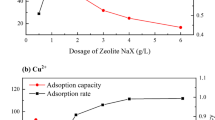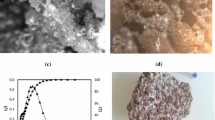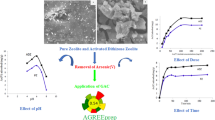Abstract
The most important natural resource for human health and well-being is water, which can be affected by different sources, such as physical, organic, chemical, and microbiological ones. CBV 760 commercial zeolite was used and tested to remove inorganic pollutants, lead, and cadmium. Adsorption isotherms were used to assess the adsorption properties of contaminants and real effluent. At the solution pH (4.5 and 5), adsorption kinetics and isotherms were conducted for lead and cadmium, respectively. The investigated zeolite was quite efficient in lead and cadmium removal, as the maximal adsorbed amounts were Qa = 175 and 148 mg g−1 for lead and cadmium, respectively, at T = 308 K. Adsorption capacity is pH dependent. Adsorption of Pb2+ and Cd2+ is highest at pH 8 (Qa = 107 and 53.58 mg g−1, respectively). The CBV 760 displays more affinity for Pb2+ than Cd2+. It is worth noticing that CBV 760 exhibits good selectivity for heavy metal retention metals, namely, Ni2+, Cu2+, Cd2+, and Pb2+, in an actual contaminated effluent with a removal yield of 80% on CBV 760.












Similar content being viewed by others
References
Li Y, Wang J-D, Wang X-J, Wang J-F (2012) Adsorption–desorption of Cd(II) and Pb(II) on Ca-Montmorillonite. nd Eng Chem Res 51(18):6520–6528. https://doi.org/10.1021/ie203063s
Gong J, Liu T, Wang X, Hu X, Zhang L (2011) Efficient Removal of heavy metal ions from aqueous systems with the assembly of anisotropic layered double hydroxide nanocrystals@carbon nanosphere. Environ Sci Technol 45(14):6181–6187. https://doi.org/10.1021/es200668q
Goldberg ED (1979) La santé des océans. Unesco, Paris, p 188
Nitta T (1972) MpiJ. Marine Pollution and Sea Life, edby M. Surrey, Fishing News (Books), Ruivo. West Byfleet, pp 77–81
Kurland LT (1960) SNF, H. SIEDLER Minamata disease. The outbreak of a neurologic disorder in Minamata, Japan, and its relationship to the ingestion of seafood contaminated by mercuric compounds. World Neurol 1:370–395
Agarwal SK (2009) HMP, Published by SB. Nangia A P H Publishing Corporation 4435–36/7:227
Simeonidis K, Mourdikoudis S, Kaprara E, Mitrakas M, Polavarapu L (2016) Inorganic engineered nanoparticles in drinking water treatment: a critical review. Environ Sci Water Res Technol 2(1):43–70. https://doi.org/10.1039/C1035EW00152H
Turhanen PA, Vepsäläinen JJ, Peräniemi S (2015) Advanced material and approach for metal ions removal from aqueous solutions. Sci Rep 5(1):8992. https://doi.org/10.1038/srep08992.10.1038/srep08992
Ciszewski D, Grygar TM (2016) A review of flood-related storage and remobilization of heavy metal pollutants in river systems. Water Air Soil Pollut 227(7):239. https://doi.org/10.1007/s11270-11016-12934-11278
Fu F, Wang Q (2011) Removal of heavy metal ions from wastewaters: a review. J Environ Manage 92(3):407–418. https://doi.org/10.1016/j.jenvman.2010.1011.1011
Razak NHA, Praveena SM, Aris AZ, Hashim Z (2015) Drinking water studies: a review on heavy metal, application of biomarker and health risk assessment (a special focus in Malaysia). J Epidemiol Glob Health 5(4):297–310. https://doi.org/10.1016/j.jegh.2015.1004.1003
Shanker AK (2019) Chromium: environmental pollution, health effects and mode of action☆. In: Nriagu J (ed) Encyclopedia of Environmental Health (Second Edition). Elsevier, Oxford 624–633. https://doi.org/10.1016/B1978-1010-1012-409548-409549.411575-409541
Mohy Eldin MS, Abu-Saied MA, Tamer TM, Youssef ME, Hashem AI, Sabet MM (2016) Development of polystyrene based nanoparticles ions exchange resin for water purification applications. Desalin Water Treat 57(32):14810–14823. https://doi.org/10.11080/19443994.19442015.11080192
Zhu R, Chen Q, Zhou Q, Xi Y, Zhu J, He H (2016) Adsorbents based on montmorillonite for contaminant removal from water: a review. Appl Clay Sci 123:239–258. https://doi.org/10.1016/j.clay.2015.1012.1024
Jurado-Sánchez B, Sattayasamitsathit S, Gao W, Santos L, Fedorak Y, Singh VV, Orozco J, Galarnyk M, Wang J (2015) Self-propelled activated carbon janus micromotors for efficient water purification. Small 11(4):499–506. https://doi.org/10.1002/smll.201402215
Liang L, Xi F, Tan W, Meng X, Hu B, Wang X (2021) Review of organic and inorganic pollutants removal by biochar and biochar-based composites. Biochar 3(3):255–281. https://doi.org/10.1007/s42773-42021-00101-42776
Fouda-Mbanga BG, Prabakaran E, Pillay K (2021) Carbohydrate biopolymers, lignin based adsorbents for removal of heavy metals (Cd2+, Pb2+, Zn2+) from wastewater, regeneration and reuse for spent adsorbents including latent fingerprint detection: a review. Biotechnol Rep 30:e00609. https://doi.org/10.01016/j.btre.02021.e00609
Renu AM, Singh K (2016) Heavy metal removal from wastewater using various adsorbents: a review. J Water Reuse Desalin 7(4):387–419. https://doi.org/10.2166/wrd.2016.2104
Ghasemi Z, Sourinejad I, Kazemian H, Rohani S (2018) Application of zeolites in aquaculture industry: a review. Rev Aquac 10(1):75–95. https://doi.org/10.1111/raq.12148
Flanigen EM (1984) Molecular sieve zeolite technology: the first twenty-five years. In: Ribeiro FR, Rodrigues AE, Rollmann LD, Naccache C (eds) Zeolites: Science and Technology. Springer Netherlands, Dordrecht 3–34. https://doi.org/10.1007/1978-1094-1009-6128-1009_1001
de Magalhães LF, da Silva GR, Peres AEC (2022) Zeolite application in wastewater treatment. Adsorpt Sci Technol 2022:4544104. https://doi.org/10.1155/2022/4544104
Mintova S (2003) Nanosized molecular sieves. Collect Czech Chem Commun 68:2032–2054. https://doi.org/10.1135/cccc20032032
Brunauer S, Emmett PH, Teller E (1938) Adsorption of gases in multimolecular layers. J Am Chem Soc 60(2):309–319. https://doi.org/10.1021/ja01269a01023
Yuh-Shan H (2004) Citation review of Lagergren kinetic rate equation on adsorption reactions. Scientometrics 59(1):171–177. https://doi.org/10.1023/B:SCIE.0000013305.0000099473.cf
Ho YS, McKay G (1998) Sorption of dye from aqueous solution by peat. Chem Eng J 70(2):115–124. https://doi.org/10.1016/S0923-0467(1098)00076-00071
Guibal E, Milot C, Tobin JM (1998) Metal-anion sorption by chitosan beads: equilibrium and kinetic studies. Ind Eng Chem Res 37(4):1454–1463. https://doi.org/10.1021/ie9703954
Freundlich H (1907) Über die Adsorption in Lösungen. Z Phys Chem 57U(1):385–470. https://doi.org/10.1515/zpch-1907-5723
Langmuir I (1918) The adsorption of gases on plane surfaces oF glass, mica and platinum. J Am Chem Soc 40(9):1361–1403. https://doi.org/10.1021/ja02242a02004
Oubagaranadin JUK, Murthy ZVP (2010) Isotherm modeling and batch adsorber design for the adsorption of Cu(II) on a clay containing montmorillonite. Appl Clay Sci 50(3):409–413. https://doi.org/10.1016/j.clay.2010.1009.1008
McKay G, Bino MJ, Altamemi AR (1985) The adsorption of various pollutants from aqueous solutions on to activated carbon. Water Res 19(4):491–495. https://doi.org/10.1016/0043-1354(1085)90041-90047
Namasivayam C, Senthilkumar S (1997) Recycling of industrial solid waste for the removal of mercury (II) by adsorption process. Chemosphere 34(2):357–375. https://doi.org/10.1016/S0045-6535(1096)00383-00389
Mozgawa W (2001) The relation between structure and vibrational spectra of natural zeolites. J Mol Struct 596(1):129–137. https://doi.org/10.1016/S0022-2860(1001)00741-00744
Joshi UD, Joshi PN, Tamhankar SS, Joshi VV, Rode CV, Shiralkar VP (2003) Effect of nonframework cations and crystallinity on the basicity of NaX zeolites. Appl Catal A: Gen 239(1):209–220. https://doi.org/10.1016/S0926-1860X(1002)00391-00395
Dabbawala AA, Vaithilingam BV, Mittal H, Wahedi YA, Khan S, Joseph T, Singaravel G, Morin S, Berthod M, Alhassan SM (2020) Synthesis and catalytic performance of zeolite-Y supported on silicon carbide in n-heptane cracking. Appl Catal A: Gen. https://doi.org/10.1016/j.apcata.2020.117866
Hamidi R, Khoshbin R, Karimzadeh R (2021) A new approach for synthesis of well-crystallized Y zeolite from bentonite and rice husk ash used in Ni-Mo/Al2O3-Y hybrid nanocatalyst for hydrocracking of heavy oil. Adv Powder Technol 32(2):524–534. https://doi.org/10.1016/j.apt.2020.1012.1029
Zhang R, Xu S, Raja D, Khusni NB, Liu J, Zhang J, Abdulridha S, Xiang H, Jiang S, Guan Y, Jiao Y, Fan X (2019) On the effect of mesoporosity of FAU Y zeolites in the liquid-phase catalysis. Micropor Mesopor Mat 278:297–306. https://doi.org/10.1016/j.micromeso.2018.1012.1003
Tolentino CMC, de Luna MDG, Futalan CM, Choi AES, Manegdeg FG, Grisdanurak N (2020) Influence of hydrocarbons on hydrogen chloride removal from refinery off-gas by zeolite NaY derived from rice husks. Sci Total Environ. https://doi.org/10.1016/j.scitotenv.2020.138782
Karge HG (1998) Characterization by infrared spectroscopy. Micropor Mesopor Mat 22(4):547–549. https://doi.org/10.1016/S1387-1811(1098)80021-80028
Oruji S, Khoshbin R, Karimzadeh R (2018) Preparation of hierarchical structure of Y zeolite with ultrasonic-assisted alkaline treatment method used in catalytic cracking of middle distillate cut: the effect of irradiation time. Fuel Process Technol 176:283–295. https://doi.org/10.1016/j.fuproc.2018.1003.1035
McCusker LB, Baerlocher C (2001) Chapter 3 Zeolite structures. In: van Bekkum H, Flanigen EM, Jacobs PA, Jansen JC (eds) Studies in surface science and catalysis, vol 137. Elsevier 37–67. https://doi.org/10.1016/S0167-2991(1001)80244-80245
Jentys A, Lercher JA (2001) Chapter 8 Techniques of zeolite characterization. In: van Bekkum H, Flanigen EM, Jacobs PA, Jansen JC (eds) Studies in Surface Science and Catalysis, vol 137. Elsevier 345–386. https://doi.org/10.1016/S0167-2991(1001)80250-80250
Hassan H, Hameed BH (2011) Oxidative decolorization of acid red 1 solutions by Fe–zeolite Y type catalyst. Desalination 276(1):45–52. https://doi.org/10.1016/j.desal.2011.1003.1018
Zhu L, Lv X, Tong S, Zhang T, Song Y, Wang Y, Hao Z, Huang C, Xia D (2019) Modification of zeolite by metal and adsorption desulfurization of organic sulfide in natural gas. J Nat Gas Eng. https://doi.org/10.1016/j.jngse.2019.102941
Gerards RTJ, Fernandes A, Graça I, Ribeiro MF (2020) Towards understanding of phenolic compounds impact on Ni- and V-USY zeolites during bio-oils co-processing in FCC units. Fuel. https://doi.org/10.1016/j.fuel.2019.116372
Paul D, Kasera N, Kolar P, Hall SG (2020) Physicochemical characterization data of pine-derived biochar and natural zeolite as precursors to catalysts. Chem Data Collect. https://doi.org/10.1016/j.cdc.2020.100573
Moon DJ, Lim WT (2020) Synthesis and single-crystal structure of sodium sulfide cationic cluster in the sodalite cavity of zeolite Y (FAU, Si/Al = 1.56). J Porous Mater 27(4):1233–1240. https://doi.org/10.1007/s10934-10020-00904-10931
Kaneko K, Ishii C, Ruike M, kuwabara H, (1992) Origin of superhigh surface area and microcrystalline graphitic structures of activated carbons. Carbon 30(7):1075–1088. https://doi.org/10.1016/0008-6223(92)90139-N
Sing KSW (1985) Reporting physisorption data for gas/solid systems with special reference to the determination of surface area and porosity (Recommendations 1984). Pure Appl Chem 57(4):603–619. https://doi.org/10.1351/pac198557040603
Amari A, Chlendi M, Gannouni A, Bellagi A (2010) Optimised activation of bentonite for toluene adsorption. Appl Clay Sci 47(3):457–461. https://doi.org/10.1016/j.clay.2009.1011.1035
Barrett EP, Joyner LG, Halenda PP (1951) The determination of pore volume and area distributions in porous substances. I. Computations from nitrogen isotherms. J Am Chem Soc 1:373–380. https://doi.org/10.1021/ja01145a01126
Ozdes D, Duran C, Senturk HB (2011) Adsorptive removal of Cd(II) and Pb(II) ions from aqueous solutions by using Turkish illitic clay. J Environ Manage 92(12):3082–3090. https://doi.org/10.1016/j.jenvman.2011.3007.3022
Sáez P, Rodríguez A, Gómez JM, Paramio C, Fraile C, Díez E (2021) H-Clinoptilolite as an efficient and low-cost adsorbent for batch and continuous gallium removal from aqueous solutions. J Sustain Metall 7(4):1699–1716. https://doi.org/10.1007/s40831-40021-00437-40830
Elwakeel KZ, El-Bindary AA, Kouta EY (2017) Retention of copper, cadmium and lead from water by Na-Y-zeolite confined in methyl methacrylate shell. J Environ Chem Eng 5(4):3698–3710. https://doi.org/10.1016/j.jece.2017.3606.3049
Arief VO, Trilestari K, Sunarso J, Indraswati N, Ismadji S (2008) Recent progress on biosorption of heavy metals from liquids using low cost biosorbents: characterization, biosorption parameters and mechanism studies. CLEAN – Soil. Air, Water 12:937–962. https://doi.org/10.1002/clen.200800167
Wang S, Vincent T, Faur C, Guibal E (2017) Modeling competitive sorption of lead and copper ions onto alginate and greenly prepared algal-based beads. Bioresour Technol 231:26–35. https://doi.org/10.1016/j.biortech.2017.1001.1066
Abollino O, Aceto M, Malandrino M, Sarzanini C, Mentasti E (2003) Adsorption of heavy metals on Na-montmorillonite. Effect of pH and organic substances. Water Res 7:1619–1627. https://doi.org/10.1016/S0043-1354(1602)00524-00529
Wang S, Dong Y, He M, Chen L, Yu X (2009) Characterization of GMZ bentonite and its application in the adsorption of Pb(II) from aqueous solutions. Appl Clay Sci 43(2):164–171. https://doi.org/10.1016/j.clay.2008.1007.1028
Giles CH, Smith D, Huitson A (1974) A general treatment and classification of the solute adsorption isotherm. I. Theoretical. J Colloid Interface Sci 47(3):755–765. https://doi.org/10.1016/0021-9797(1074)90252-90255
Neskoromnaya EA, Khamizov RK, Melezhyk AV, Memetova AE, Mkrtchan ES, Babkin AV (2022) Adsorption of lead ions (Pb2+) from wastewater using effective nanocomposite GO/CMC/FeNPs: kinetic, isotherm, and desorption studies. Colloids Surf, A. https://doi.org/10.1016/j.colsurfa.2022.130224
Airoldi C, Critter SAM (1997) Brazilian red latosol a typic soil as an exchanger: a thermodynamic study involving Cu, Zn, Cd, Hg, Pb. Ca and Na. Clays Clay Min 45(2):125–131. https://doi.org/10.1346/CCMN.1997.0450201
González MT, Molina-Sabio M, Rodríguez-Reinoso F (1994) Steam activation of olive stone chars, development of porosity. Carbon 32(8):1407–1413. https://doi.org/10.1016/0008-6223(1494)90133-90133
Adebowale KO, Unuabonah IE, Olu-Owolabi BI (2006) The effect of some operating variables on the adsorption of lead and cadmium ions on kaolinite clay. J Hazard Mater 134(1):130–139. https://doi.org/10.1016/j.jhazmat.2005.1010.1056
Hang Y, Si Y, Zhou Q, Yin H, Wang A, Cao A (2019) Morphology-controlled synthesis of calcium titanate particles and adsorption kinetics, isotherms, and thermodynamics of Cd(II), Pb(II), and Cu(II) cations. J Hazard Mater. https://doi.org/10.1016/j.jhazmat.2019.120789
Wu D, Wang Y, Li Y, Wei Q, Hu L, Yan T, Feng R, Yan L, Du B (2019) Phosphorylated chitosan/CoFe2O4 composite for the efficient removal of Pb(II) and Cd(II) from aqueous solution: adsorption performance and mechanism studies. J Mol Liq 277:181–188. https://doi.org/10.1016/j.molliq.2018.1012.1098
Khaled A, El Nemr A, El-Sikaily A, Abdelwahab O (2009) Treatment of artificial textile dye effluent containing Direct Yellow 12 by orange peel carbon. Desalination 238(1):210–232. https://doi.org/10.1016/j.desal.2008.1002.1014
Hameed BH, Daud FBM (2008) Adsorption studies of basic dye on activated carbon derived from agricultural waste: Hevea brasiliensis seed coat. Chem Eng J 139(1):48–55. https://doi.org/10.1016/j.cej.2007.1007.1089
Allen SJ, McKay G, Khader KYH (1989) Intraparticle diffusion of a basic dye during adsorption onto sphagnum peat. Environ Pollut 56(1):39–50. https://doi.org/10.1016/0269-7491(1089)90120-90126
Qu J, Tian X, Jiang Z, Cao B, Akindolie MS, Hu Q, Feng C, Feng Y, Meng X, Zhang Y (2020) Multi-component adsorption of Pb(II), Cd(II) and Ni(II) onto microwave-functionalized cellulose: kinetics, isotherms, thermodynamics, mechanisms and application for electroplating wastewater purification. J Hazard Mater. https://doi.org/10.1016/j.jhazmat.2019.121718
Eren E, Cubuk O, Ciftci H, Eren B, Caglar B (2010) Adsorption of basic dye from aqueous solutions by modified sepiolite: equilibrium, kinetics and thermodynamics study. Desalination 252(1):88–96. https://doi.org/10.1016/j.desal.2009.1010.1020
He J, Li Y, Wang C, Zhang K, Lin D, Kong L, Liu J (2017) Rapid adsorption of Pb, Cu and Cd from aqueous solutions by β-cyclodextrin polymers. Appl Surf Sci 426:29–39. https://doi.org/10.1016/j.apsusc.2017.1007.1103
Sprynskyy M, Buszewski B, Terzyk AP, Namieśnik J (2006) Study of the selection mechanism of heavy metal (Pb2+, Cu2+, Ni2+, and Cd2+) adsorption on clinoptilolite. J Colloid Interface Sci 304(1):21–28. https://doi.org/10.1016/j.jcis.2006.1007.1068
Amarasinghe BMWPK, Williams RA (2007) Tea waste as a low cost adsorbent for the removal of Cu and Pb from wastewater. Chem Eng J 132(1):299–309. https://doi.org/10.1016/j.cej.2007.1001.1016.10.1016/j.cej.2007.01.016
Belviso C (2020) Zeolite for potential toxic metal uptake from contaminated soil: a brief review. Processes 8(7):820. https://doi.org/10.3390/pr8070820
Dai S, Wang N, Qi C, Wang X, Ma Y, Yang L, Liu X, Huang Q, Nie C, Hu B, Wang X (2019) Preparation of core-shell structure Fe3O4@C@MnO2 nanoparticles for efficient elimination of U(VI) and Eu(III) ions. Sci Total Environ 685:986–996. https://doi.org/10.1016/j.scitotenv.2019.1006.1292
Li S, Dong L, Wei Z, Sheng G, Du K, Hu B (2020) Adsorption and mechanistic study of the invasive plant-derived biochar functionalized with CaAl-LDH for Eu(III) in water. J Environ Sci 96:127–137. https://doi.org/10.1016/j.jes.2020.1005.1001
Liu L, Luo X-B, Ding L, Luo S-L (2019) 4 - Application of nanotechnology in the removal of heavy metal from water. In: Luo X, Deng F (eds) Nanomaterials for the removal of pollutants and resource reutilization. Elsevier 83-147. https://doi.org/10.1016/B1978-1010-1012-814837-814832.800004-814834
Hamdaoui O, Naffrechoux E (2007) Modeling of adsorption isotherms of phenol and chlorophenols onto granular activated carbon: Part I. Two-parameter models and equations allowing determination of thermodynamic parameters. J Hazard Mater 147 (1):381–394. https://doi.org/10.1016/j.jhazmat.2007.1001.1021
Puspitasari T, Ilmi MM, Nurdini N, Mukti RR, Radiman CL, Darwis D, Kadja GTM (2019) The physicochemical characteristics of natural zeolites governing the adsorption of Pb2+ from aqueous environment. Key Eng Mater 811:92–98. https://doi.org/10.4028/www.scientific.net/KEM.4811.4092
Vassileva PS, Radoykova TH, Detcheva AK, Avramova IA, Aleksieva KI, Nenkova SK, Valchev IV, Mehandjiev DR (2016) Adsorption of Ag+ ions on hydrolyzed lignocellulosic materials based on willow, paulownia, wheat straw and maize stalks. Int j sci environ technol 13(5):1319–1328. https://doi.org/10.1007/s13762-13016-10970-y
Araújo CST, Almeida ILS, Rezende HC, Marcionilio SMLdO, León JJL, Matos TN (2018) Elucidation of mechanism involved in adsorption of Pb(II) onto lobeira fruit (Solanum lycocarpum) using Langmuir, Freundlich and Temkin isotherms. Microchem J 137:348–354. https://doi.org/10.1016/j.microc.2017.1011.1009
Ehrlich G (1963) Physical adsorption of gases: D.M. Young and A.D. Crowell: Butterworths, London (1962). 426 pp. 70s. J Phys Chem 24(9):1150. https://doi.org/10.1016/0022-3697(1163)90031-90033
Bachmann SAL, Calvete T, Féris LA (2021) Caffeine removal from aqueous media by adsorption: an overview of adsorbents evolution and the kinetic, equilibrium and thermodynamic studies. Sci Total Environ. https://doi.org/10.1016/j.scitotenv.2020.144229
Gupta VK, Gupta M, Sharma S (2001) Process development for the removal of lead and chromium from aqueous solutions using red mud—an aluminium industry waste. Water Res 35(5):1125–1134. https://doi.org/10.1016/S0043-1354(1100)00389-00384
Hamoudi SA, Hamdi B, Brendlé J (2018) Chapter 4.7 - Removal of ions Pb2+ and Cd2+ from aqueous solution by containment geomaterials. In: Dincer I, Colpan CO, Kizilkan O (eds) Exergetic, Energetic and Environmental Dimensions. Academic Press, pp 1029–1043. https://doi.org/10.1016/B1978-1020-1012-813734-813735.800058-813735
Dhaouadi F, Sellaoui L, Chávez-González B, Elizabeth Reynel-Ávila H, Diaz-Muñoz LL, Mendoza-Castillo DI, Bonilla-Petriciolet A, Lima EC, Tapia-Picazo JC, Lamine AB (2021) Application of a heterogeneous physical model for the adsorption of Cd2+, Ni2+, Zn2+ and Cu2+ ions on flamboyant pods functionalized with citric acid. Chem Eng J. https://doi.org/10.1016/j.cej.2020.127975
Orumwense FFO (1996) Removal of lead from water by adsorption on a kaolinitic clay. J Chem Technol Biotechnol 65(4):363–369. https://doi.org/10.1002/(SICI)1097-4660(199604)199665:199604>199363::AID-JCTB199435<199603.199600.CO;199602-199603
Yavuz Ö, Altunkaynak Y, Güzel F (2003) Removal of copper, nickel, cobalt and manganese from aqueous solution by kaolinite. Water Res 37(4):948–952. https://doi.org/10.1016/S0043-1354(1002)00409-00408
Unuabonah EI, Adebowale KO, Olu-Owolabi BI, Yang LZ, Kong LX (2008) Adsorption of Pb (II) and Cd (II) from aqueous solutions onto sodium tetraborate-modified Kaolinite clay: equilibrium and thermodynamic studies. Hydrometallurgy 93(1):1–9. https://doi.org/10.1016/j.hydromet.2008.1002.1009
Barkat M, Nibou D, Amokrane S, Chegrouche S, Mellah A (2015) Uranium (VI) adsorption on synthesized 4A and P1 zeolites: equilibrium, kinetic, and thermodynamic studies. C R Chim 18(3):261–269. https://doi.org/10.1016/j.crci.2014.1009.1011
Saha UK, Taniguchi S, Sakurai K (2001) Adsorption behavior of cadmium, zinc, and lead on hydroxyaluminum– and hydroxyaluminosilicate–montmorillonite complexes. Soil Sci Soc Am J 65(3):694–703
Es-sahbany H, Hsissou R, El Hachimi ML, Allaoui M, Nkhili S, Elyoubi MS (2021) Investigation of the adsorption of heavy metals (Cu Co, Ni and Pb) in treatment synthetic wastewater using natural clay as a potential adsorbent (Sale-Morocco). Mater Today: Proc 45:7290–7298. https://doi.org/10.1016/j.matpr.2020.7212.1100.10.1016/j.matpr.2020.12.1100
Kong Q, Shi X, Ma W, Zhang F, Yu T, Zhao F, Zhao D, Wei C (2021) Strategies to improve the adsorption properties of graphene-based adsorbent towards heavy metal ions and their compound pollutants: a review. J Hazard Mater. https://doi.org/10.1016/j.jhazmat.2021.125690
Author information
Authors and Affiliations
Corresponding author
Ethics declarations
Competing interests
The authors declare no competing interests.
Additional information
Publisher's Note
Springer Nature remains neutral with regard to jurisdictional claims in published maps and institutional affiliations.
Rights and permissions
Springer Nature or its licensor (e.g. a society or other partner) holds exclusive rights to this article under a publishing agreement with the author(s) or other rightsholder(s); author self-archiving of the accepted manuscript version of this article is solely governed by the terms of such publishing agreement and applicable law.
About this article
Cite this article
Hamoudi, S.A., Khelifa, N., Nouri, L. et al. Removal of Pb2+ and Cd2+ by adsorption onto Y zeolite and its selectivity of retention in an actual contaminated effluent. Colloid Polym Sci 301, 631–645 (2023). https://doi.org/10.1007/s00396-023-05089-y
Received:
Revised:
Accepted:
Published:
Issue Date:
DOI: https://doi.org/10.1007/s00396-023-05089-y




